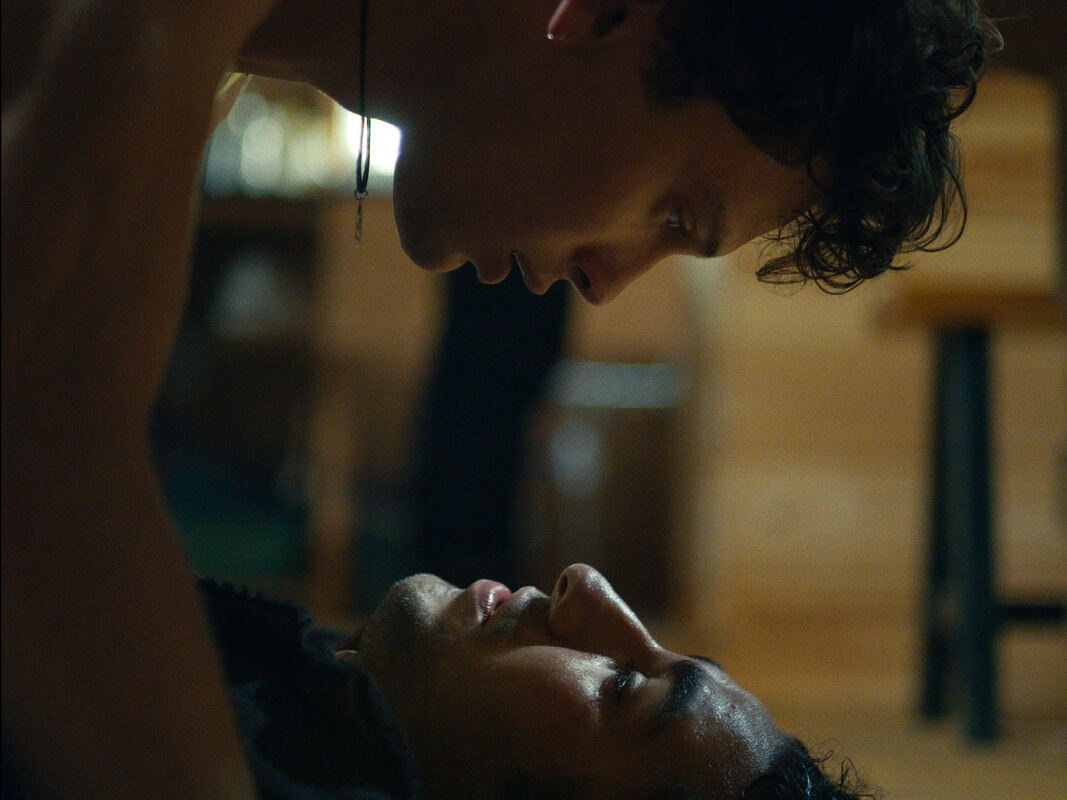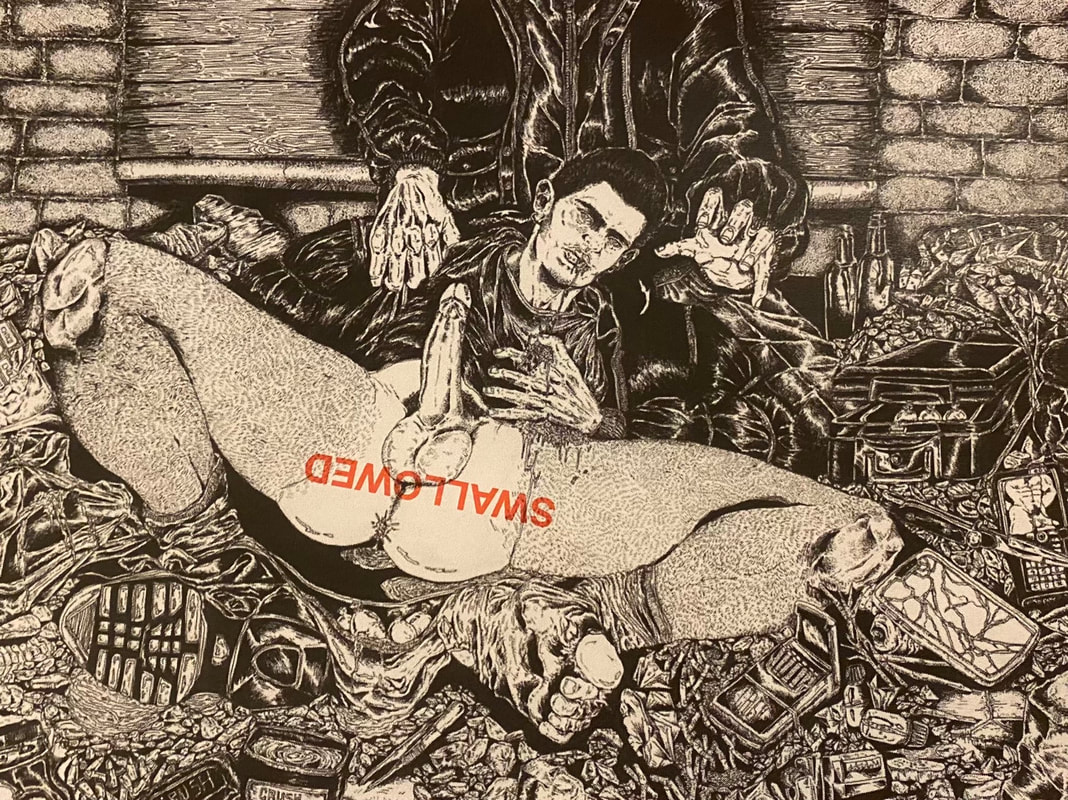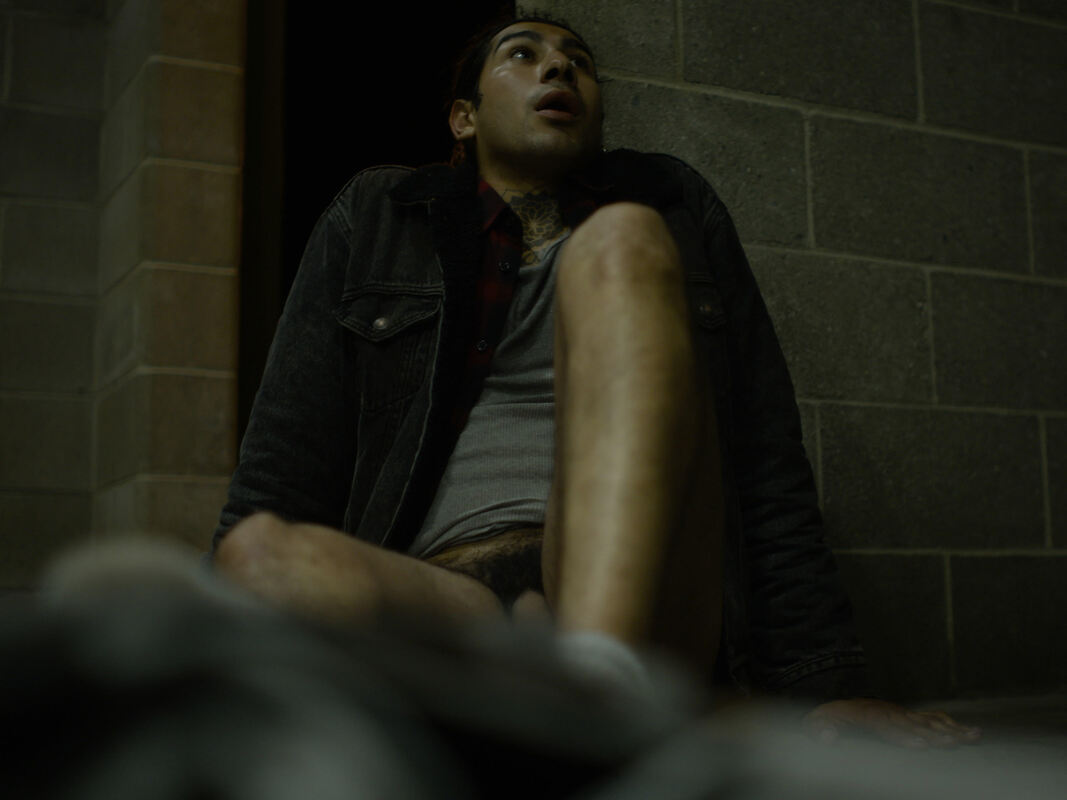|
Interview by Sean Boelman
The Overlook Film Festival is well-known among the horror community to be a great showcase for some of the most exciting genre films that you will see all year. One of the films that was set to make its World Premiere at the festival was Swallowed, seasoned horror director Carter Smith’s extraordinarily queer horror flick, and it is quite the film to behold.
We at disappointment media got the opportunity to sit down with Smith in advance of the film’s premiere to talk about the film, seeing penis in horror films, queer representation in horror, and how making indie horror is different than making studio horror. Check out the interview below and make sure to see Swallowed when it comes to a festival near you! On Seeing Penis in Horror Films
disappointment media: So first of all, there's this extraordinary artwork I've been given right before this interview began. What is the nature of this?
Carter Smith: There's an artist that I follow on Instagram, named Christian Santiago and I'm just in love with his drawings. He does these sort of intricate, large scale drawings that are all kind of queer horror based. And early on, I was like, "If I send you the script, would you maybe like, draw a picture? Would you like to do a piece for me?" And so I send the script and he's like, "I want to do something from the bathroom scene. And so this is what he came up with." disappointment: That's awesome. Smith: So you have to include this so people know what we're talking about, hahaha.
disappointment: I was talking about the film yesterday with some people who hadn't seen it yet. One of the selling points was that there is an exceptional amount of penis in the film.
Smith: There is. That was very important from the inception. disappointment: Why do you think that was important? Smith: I spent so many years as a young gay kid, like looking for penis in the horror movies that I loved. And it was never there. I did it to provide for the younger generation. disappointment: And you know, I think that that's something that is really special about indie horror. Like, you've worked in both studio horror and indie horror. Do you think that indie horror gave you that freedom to make those creative choices? Smith: Yeah, I mean, there definitely wasn't anyone saying that I couldn't do something. You know, like when I made The Ruins, there was a scene in the hotel when they're hungover and they're getting ready to go out. And it became a huge discussion and conversation about even showing a guy's butt after it. But yet there was like, mandatory nudity for one of the girls. And like, I don't agree with that at all. And so it was nice to, you know, sort of have a flip side of that, where I could do whatever I wanted. disappointment: Yeah. Do you think that there's this double standard in terms of horror filmmaking and you know, showing female nudity versus not showing male nudity? Smith: I mean, I think it's changing. People are getting a lot more comfortable with seeing dick. And, you know, it's always been butt, but I feel like audiences have gotten a lot more used to seeing at all. On Queer Horror
disappointment: So obviously, this is a very queer horror film. What do you think is the importance of queer genre cinema?
Smith: Just seeing yourself in the films you love. Seeing characters that act like you and look like you and talk like you and love like you, that's super important. And that kind of can't be discounted for young people watching films, seeing themselves is so important. And I mean, sure, you can watch like, you know, awkward coming of age, sort of traditional queer movies. But like, there hasn't traditionally been a whole lot of representation in real genre cinema. So given the chance to, "Okay, go do whatever you want," which this was, I was like, "Okay, this is what I want" disappointment: What do you think some of your favorite queer genre films would be? Smith: I mean, I do have a soft spot for Nightmare on Elm Street 2. If for no other reason, just because seeing Mark Patton in that movie was the first time that I felt like I saw myself. You know, I was a teenager in bumfuck, middle of nowhere, Maine. And there was someone who was like, "Oh my God, he dares to wear that yellow shirt that I wish I could wear to school, but I don't, I can't." So that was a really big one for me. Now there's lots more. Like, I love Erlingur Thoroddsen's movie, Rift, the Icelandic movie. I think also, there's this tendency now that films don't have to be only a queer horror film. Like it can have queer characters that that's not the source of the suffering. It's not the source of the evil. They're just sort of part of the story, which I find really interesting. When it becomes less about someone being queer and more about them just as a fully developed character in an otherwise horrifying movie. disappointment: Yeah, I definitely agree with that. I think that that is kind of the next step for representation. And I think you do a great job of that in this film, how you know, the characters are fundamentally queer– Smith: But that's not what it's about. I mean, it kind of is, because it is sort of a love story. I mean, there is that element to it, but it's not front and center in a way that you might expect. On Casting the Film
Boelman: And you talked about Mark Patton, he's in this film. I absolutely loved his performance. I think it's probably my favorite part of the movie. What was it like getting him to be in the film?
Smith: You know, I wrote the part for him. And having never met him and only after seeing Scream, Queen!, and then, when I wrote it, I was like, "This would be fucking amazing for Mark," And I just sent him a message on Instagram. And was kind of relentless and kept messaging him, and got his email and sent him the script and sent him a package. And he didn't get it at first, what it was all about. He didn't even realize that I was actually offering him a part in this. And when he did, he was kind of taken aback and he was scared to death of it in a lot of ways. Because, you know, it's a pretty juicy part. And in the way we were shooting it with a micro budget, tiny crew, remote, remote, remote. It had a lot of challenges. But he was a trooper, and like, fully showed up. And it was kind of amazing. disappointment: There aren't a lot of movies that have those juicy parts for older queer actors. Can you talk about this film and that role's significance in that regard? Smith: I think that so much of queer cinema, especially, is focused on youth, and coming of age, and like these beautiful boys on swim teams longingly looking across the pool. And that's part of a queer experience. But you certainly don't stop being queer when you're in your 50s and 60s and 70s and beyond. So, I think that, it just kind of goes towards telling stories that are fleshed out with real characters that just happen to be queer. And then it's not necessarily like, why they're in the story, but that's just part of who they are. disappointment: You also have Jena Malone in this film. Yeah, she's great as well. I was actually watching the film, and I'm like, "I wonder when Jena Malone is going to show up?" And then it just dawned on me that it was her because like, her performance was that transformative. Can you talk a bit about her performance? Smith: That’s awesome. Again, she was someone who I wrote with it in mind. The whole project was conceived to be something that I could do with a very small crew and with things that I had access to. I knew that we were already friends from doing The Ruins. And so I knew I could text her, because we talked about doing something and it just hadn't come together yet. It was very much like I wrote it with her in mind, this kind of badass, tough, I don't know how you would describe her character exactly. But she also was someone that, because she's been on sets for so long and she's been working for so long, she helped, in a way, everything that we did, she elevated it. Everyone was like, "Okay, we're on our A-game." Even if it's like Jose's first movie that he has ever been in, for him to be able to watch her and how she works was incredible. disappointment: You mentioned Jose Colon. And Cooper Koch is also a relatively new actor. How did you find the two of them? Smith: Jose, I found. I am also a photographer. I shoot this series of portraits called "All the Dead Boys," and he was someone who I'd photographed for it. And I just found him super interesting. And took the photos, like went off. A couple weeks later, I was editing and it was the same time I was sort of starting to think about the script. And I just had these pictures out. And I was like, "Oh, his name is Dom. He seems like this sweet, potential redneck rural, straight guy with a heart of gold who his best friend might fall in love with." So it was very much written for him which was, which was super exciting for him, but also for me, because I was writing to what I knew. And he was amazing. And Cooper, I had actually met Cooper a couple of years before just sort of briefly. And that was the one role that we ended up like having people put themselves on tape for and actually did a proper little bit of casting. And he was just incredible. It was clear from the very first moment I watched his tape. disappointment: That's a very hard role, obviously. How did you work with him to get through those difficult moments? Smith: I mean, he was pretty game. Everyone knew what they were signing up for it and everyone sort of knew, this was gonna be a really tough shoot. There's a lot of material here that is potentially tricky, and we're gonna roll up our sleeves, and we're gonna get dirty and slimy, and everyone sort of had to sign on to work in that way, before I felt comfortable, saying, "Okay, you're on Team Swallowed." If you have a problem helping to carry our catering in or out of location, we don't want you. You have to, you have to pitch in and help. On the Film's Aesthetic and Atmosphere
disappointment: The whole film has this grimy aesthetic that's very very discomforting. How did you come to build this aesthetic?
Smith: The whole aesthetic is very rural Maine, which is where we shot and which is where I grew up. And just the overpowering beauty of the natural setting in the forest, that was where a lot of it started. And like the camp that we shot at, that's an off-the-grid camp that my dad and he forced me to help him a little bit when I was a teenager. I went begrudgingly, and thank God I did, because now we had a camp that I could shoot at. But a lot of it is for the most part in daylight, so like the sliminess, it's a good texture. Imagine, like when you see a really slimy, weird slug, and it's covered with debris and bits of fur, dead leaves. And there's something about that contrast that I was really fascinated with. disappointment: Something I really loved about the film is that, you know, you've got this atmosphere that's really uncomfortable and unsettling, but you don't really use jump scares. So how did you kind of go about, like, making that tension throughout the film? Smith: I mean, jump scares, I'm not a fan of for the most part anyway. For me, building a sense of dread and unease is always my favorite thing to try to figure out how to do any and every way possible. I think that once you realize what has happened in the film, and what has to happen afterwards, that's uncomfortable for most audience members, I would dare say. So, as much as anything, it's the psychological aspect of thinking that you have to face what these characters go through, it immediately makes people uncomfortable. disappointment: There's a lot of minimalism to the film as well, I would say. You don't show a lot of the creatures, which I mean, part of that, I'm assuming, is probably budget constraints that you couldn't show a lot. But it also makes it more unsettling, I think. Those quick flashes of it let you imagine it. Smith: And they're super simple. The creature design, everything about them is very simple. And from the beginning, I knew that we were going to be limited. We'd be shooting in daylight and we did want to do everything practically. So I knew that was going to be the box that we were playing in. And that maybe we might get a little bit of digital help afterwards if it was necessary, but it wasn't planned that way. It was planned to be 100% practical. And I had met Dan Martin, the special effects designer, here at the Overlook a couple of years ago at the closing party, and we just hit it off. And he ended up doing the creature work on this. And it was super fun to do something practical. Like I've done digital stuff, and I've done some practical stuff, but like a practical creature, I guess if you want to call it a creature, was really fun. Because it was practical, there's a lot of clamps and springs. And then you get these cramps in your hand from puppeteering. I still have carpal tunnel from puppeteering the creatures. disappointment: I also really liked the cinematography, the aspect ratio was very small and I would say claustrophobic. Can you talk a bit about that? Smith: I knew I wanted it to feel super claustrophobic. Not only are they sort of trapped for the second half of the movie in this little cabin, surrounded by nothing but open space, I liked the idea of shooting in that aspect ratio. And because also, a face looks so good in that ratio. To me, a close up works so much better when the film is in 4:3, it looks so great in 4:3. And, you know, widescreen or 16:9 or any other formats, it starts to be less impactful in a lot of ways. And knowing the room that we were going to be in a lot of the film, I was like, "Okay, I'd rather have a frame full of face than a frame with 1/3 face and two thirds of this room that's going to get boring to look at." And Alex Wolf Lewis, who shot the film, he's actually a documentary shooter. This is his first narrative feature. He's very much used to kind of going into a space, not lighting it, following whatever happens and shooting it that way. So that's how we approached it in the film. disappointment: On one hand, this film is very grounded, you've got the thriller elements, like the crime elements that are very grounded. And then you have this kind of sci-fi/horror thing in it. How did you find the balance between the two to make it so unnerving? Smith: I always felt like the, the natural, the sci-fi element to me it's actually not that sci-fi because it's 100% plausible, right? There are, there are so many versions of natural animals, venoms, that people have been taking, ingesting, using, injecting for hundreds of years. So, to me, it's less sci-fi and more a strange northern Maine drug subculture. But I knew that none of that stuff would work if the rest of the film wasn't pretty grounded, both in character and reality and the textures, all the locations. It was all very real. And that's kind of what we set out from the beginning to make sure so that when things go a little crazy and get a little less real, you buy it in that world.
Swallowed premiered at the 2022 Overlook Film Festival, which ran June 2-5. It can next be seen at the Fantasia International Film Festival in July.
0 Comments
Leave a Reply. |
Archives
March 2024
Authors
All
|
|
|
disappointment media
Dedicated to unique and diverse perspectives on cinema! |



